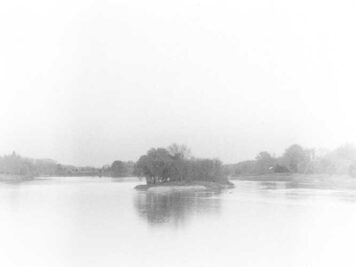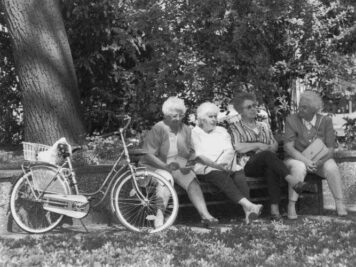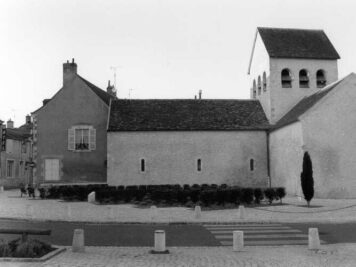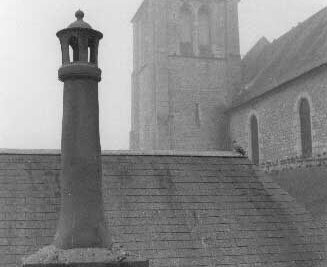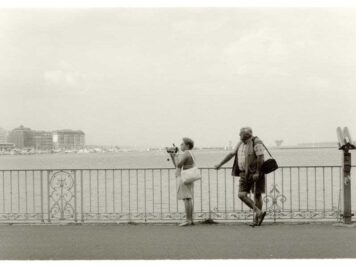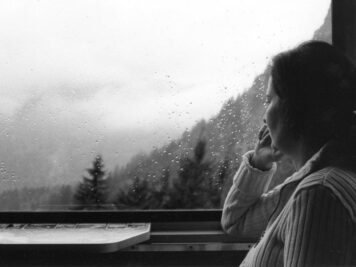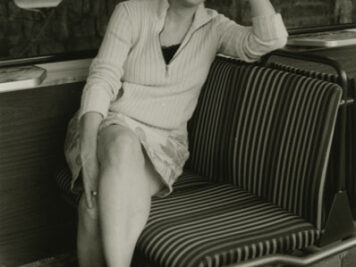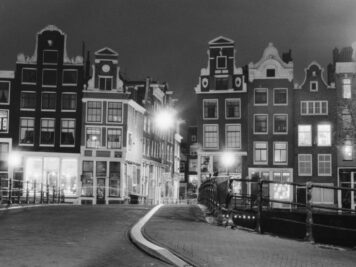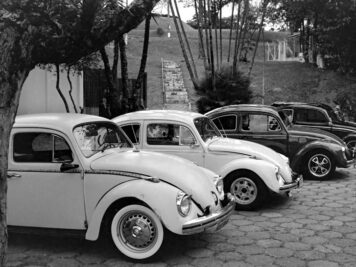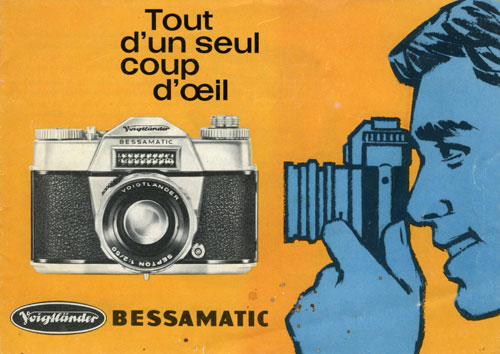
Bessamatic was launched in 1959 by one of the most traditional German firms in the field of photography, Voigtlander, the same company that manufactured the first truly photographic lens in 1840, the Petzval lens. Unfortunately, Bessamatic would be one of the last releases of this pioneer of photography. Even before launching Bessamatic, since 1956, Voigtlander was already part of the Zeiss Ikon group. At the beginning of the 1970s, all production was shut down.
Analyzing Bessamatic one can easily find some clues to understand the reasons for this end. From the quality point of view, it is exquisite, a worthy representative of the excellence of the German photographic industry, but the concept is tied to some premises of the past that would prevent the continuation of a line of cameras of the Bessamatic type. It is a pity because the moment was ideal for a monoreflex, the category was about to take a huge leap, both in the professional and amateur market, but the fact is that it did not meet the expectations that would become the practice in the market.
The central type shutter, a Synchro Compur, is an engineering gem, but it is expensive, complex and imposes limitations of geometry for the lenses, since the two share the same reduced space of a 35mm monoreflex. The focal plane shutters conveniently separate the optics from the exposure time control mechanism and leave more room for the movable mirror. It is strange that they insisted on this type of construction on a monoreflex in the late 1950s. Leicas and Contaxes, two rangefinders, should have drawn attention to the advantages of curtain shutters. Even more striking, the Kine Exakta, the first monoreflex for 35 mm film, has been in existence since 1936 with a curtain shutter. That would have been an excellent benchmark. But they probably had in mind to compete with Contaflex, from Zeiss Ikon, and Retina Reflex, from Kodak Ag, and incurred into the same error.
The Japanese, in turn, at the same time adopted for their SLRs (Single Lens Reflex) the focal plane shutter, a system that would soon come to dominate the market completely. Leaf shutter would hardly be able to accommodate a normal lens, say 50 mm with f/1.8 aperture, on a 24×36 mm frame camera. I think a f/1.4 or f/1.2 would be impossible. The area that actually opens in such shutters is relatively small. If it is too big, there is a sacrifice in speed for action scenes. Also, the shorter lenses are very difficult to design, because between them and the film it is necessary to accommodate the mirror and the shutter.

Less problematic, but also a bet on which Bessamatic lost, concerns the position of the controls. Voigtlander was creative in that respect. They insisted a lot, for example on a focus adjusted on the camera body instead of the most obvious helical in the lens tube itself. This was the case with Prominent, Vitessa and Bessa II. At Bessamatic they finally agreed to put the focus like a ring on the lens. But as for speed and aperture, they went against the trends.

Focal plane shutters have taken speed control to the top of the camera, such as the Nikon and Canon, for example. Most obvious position since the curtains are actually at the rear. Equally obvious, they left the aperture adjustment like a ring on the lens tube to activate the iris. For Bessamatic, Voigtlander’s engineers did the opposite. They left the speeds like a ring on the lens tube (natural for a leaf-shutter) but took the iris adjustment to the top of the camera! Away from the iris. This called for an additional mechanism so that by rotating a ring with a vertical axis on the left side of the camera, the f-stops could be changed down there in the lens.
I tend to think that the ring adjustments on the lens should be the ones we make last, right before firing the shutter. I also believe that the most logical sequence is usually: speed, aperture and focus. In this sense, the system that was enshrined in speed at the top of the camera and aperture and tube in the lens, seems to me the most logical from usage standpoint. Perhaps Bessamatic has lost a little more competitiveness on this point. At least, it was the opposite of what was established in the SLR camera market. Creativity that worked, with respect to the controls, was the Olympus OM, which has the three controls on the lens tube. It is the system that I like the most.
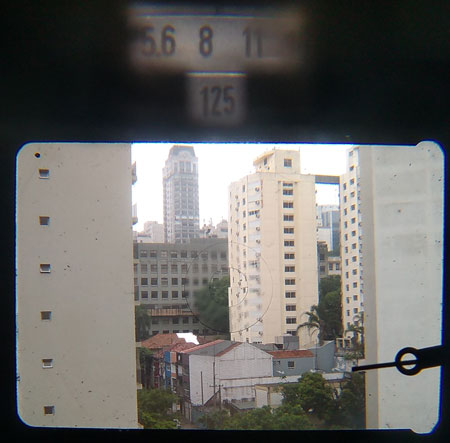
But enough to talk about points where the camera was already out of date in relation to what was happening in the market. Some things were very convenient and even new. Above is the viewfinder of the Bessamatic Deluxe. Although the light meter is not through the lens, you can adjust it by following it on the viewfinder. The needle fluctuates according to the lighting and when we vary the opening or speed, we have to match the needle with an indicator that goes up and down when we change the speed / opening. That way we find the right photometry. Bessamatic uses a selenium light meter, positioned as a window in the prism housing, and therefore does not need any batteries.
But the most interesting thing, which was not even present in the Bessamatic right from the start in 1959, but which came to be incorporated in a Deluxe model, launched in 1962, was the possibility of reading speed and aperture directly in the viewfinder. It is very curious the solution given to this problem at a time when there was no electronics in photography. A second prism was placed on top of the regular prism, with a small T-shaped window, and it brings an image of the lens’ rings marks to the top of the viewfinder. In the photo above, we are in 1/125 s and slightly more closed than f/8.
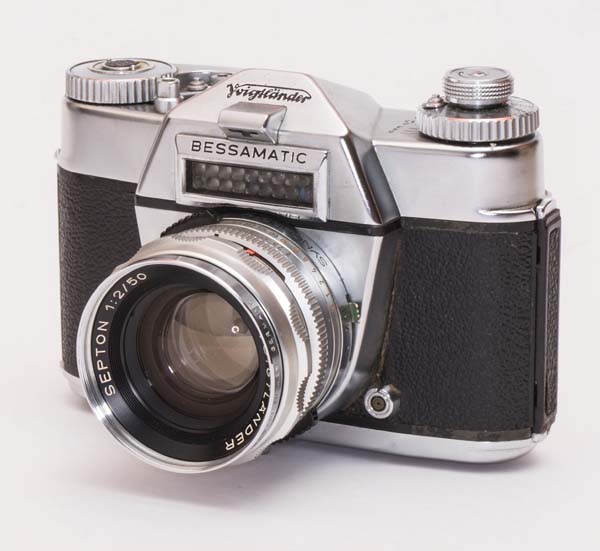
The optics available to Bessamatic form a very extensive set for the time. They use a bayonet system and there are ten options from 35 to 350 mm. The standard lens is the Color Skopar 50 mm f / 2.8, same concept as Zeiss’ Tessar as can be seen in the illustration below. This is an optics with great performance and that equipped most of the Voigtlander folding cameras for 35 mm and 120 films as well. One step up, more sophisticated and more luminous, is the Septon 50 mm f/2.0, a lens with seven elements as the name implies. The super premium is the Skopagon 40 mm f/2.0, a lens that reaches very high prices among collectors. These optics only became possible thanks to the improvement of anti-reflective treatment methods in the 60’s. Skopagon has 9 elements in 6 groups.

The finish of the lenses for Bessamatic is very good and it is not uncommon to find these lenses looking like new until today. It is very elegant and pleasant to use leather in the focusing ring for longer lenses. Lens caps are flexible and hold very well even without clicks or mechanisms.
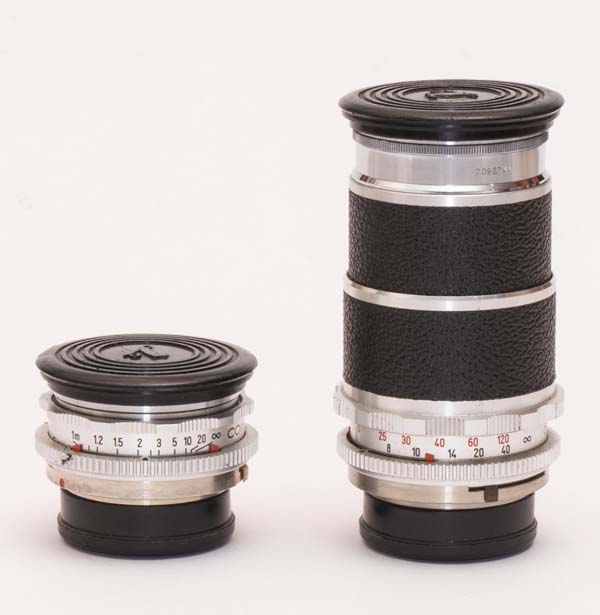
Skoparex 35 mm f/3.4 and Super Dynarex 135 mm f/4
Another fancy thing, very interesting in use, is that in the lens body, instead of the usual engraved depth-of-field scale, the optics for Bessamatic feature two moving pointers (see the red tips in the photos above) that open and close according to the selected aperture. It is very easy to adjust the focus zone with these indicators. This is a characteristic that is also found in the sophisticated Hasselblad, but I do not know who was the pioneer.

Skoparex 35 mm f/3.4 and Super Dynarex 135 mm f/4
Very well thought out was also to use, as much as possible, the same filter thread and accessories for most optics. This became standard, but it was not present in the Contaflex of Zeiss Ikon (1953) or in the Retina Reflex of Kodak (1957), which would be the most direct competitors of Bessamatic in this generation of the 50s.
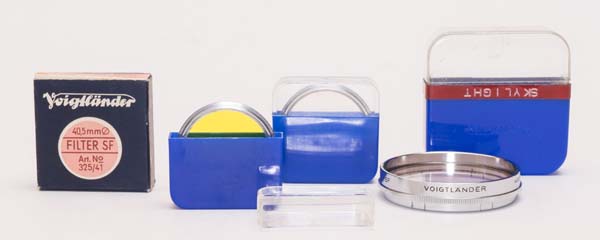
The Color Skopar 50 mm f/2.8, the Skoparex 35 mm f/3.4 and the Super Dynarex 135 mm f/4, use the same 40.5 mm thread for filters. That was the elegant basic kit for a Bessamatic with normal, angular and tele lenses.

In addition to the colored filters, Voigtlander also offered sets of close-up lenses.
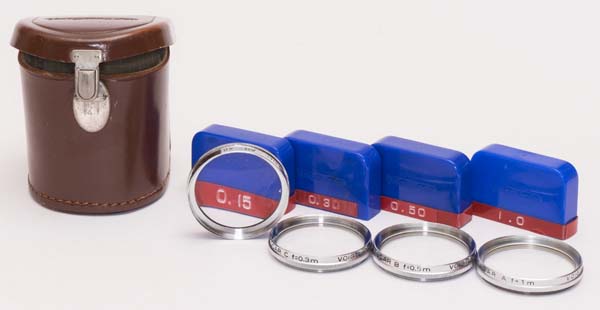
This was interesting because, unlike the lenses that would come to equip Japanese monoreflex cameras, with a focus as near as 45 or 50 cm, the minimum focus for the normal lens was 90 cm. The close-up lenses allow a smaller framing in a very practical and straightforward way.
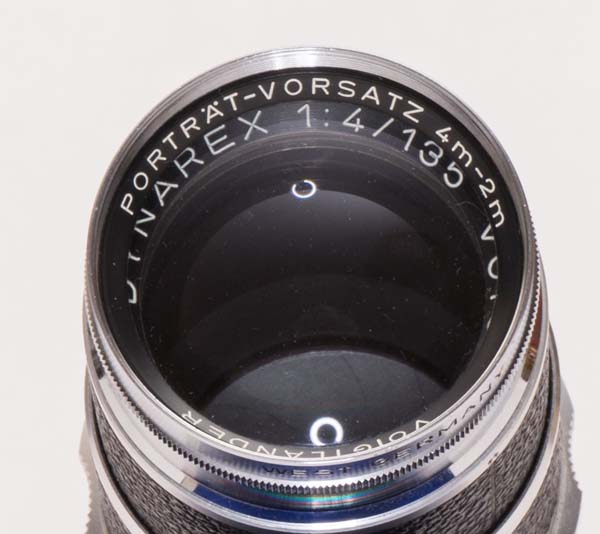
There was also, for the Super Dynarex 135 mm f/4, a special auxiliary lens for portraits. Usually the Super Dynarex focuses up to a distance of 4 meters. With this extra lens you can focus between 4 and 2 m. This gain, for a 135 mm, already allows for a very closed framing for a portrait.

With Septon, being 50 mm f/2.0, it was not possible to keep the filter thread at 40.5 mm. But Voigtlander obviously offered a complete set of accessories also for the more sophisticated optics.
The first Zoom lens was for the Bessamatic
There were already zoom lenses, lenses with variable focal length, before the Bessamatic. They have been in telescopes since 1834, probably just to make it easier to aim. In cinema, the first use of a zoom lens was in the opening scene of the silent film “It”, which can be seen on Youtube (from 2:00 to 2:30 min – source Wikipedia). However, for photography the design difficulties were greater.
- In cinema, moving scenes require less quality, less definition across the image field. We do not analyse much, we do not scan all the details and we tend to follow what is moving and which is usually more in the center.
- In the cinema, with the film running vertically, only half a frame is used, that is: 18 x 24 mm.
This means that for photography, the lens designer not only had to produce a sharper image in the entire field of the image, but that image still had to be twice as large as the one requested by the cinema lenses.
It must also be a point that perhaps the demand for zoom lenses in photography would have been non-existent until then. Only on a monoreflex camera does a zoom lens make any sense and this system was still in development in the 1950s. Exakta was the first SLR with 35mm films in 1936, but other manufacturers, with greater weight, took a while to enter and consolidate the new segment.
In any case, it is common ground today that the Voigtlander Bessamatic was the first 35 mm camera to feature a zoom lens. It is called Zoomar.

With it, you can vary from 36 to 82 mm. It probably weighs more than a 35 mm + 50 mm + 90 mm of the same Voigtlander. But it should be a source of great pride for early adopters to be able to experience the infinite possibilities between 36 and 82 mm.

Above is a comparison of the same subject photographed with Zoomar at 82mm, on the left, and 36mm, on the right. Both at f/8. Although automobiles are roughly contemporaneous with the camera, the photo was taken in Dec/2021.
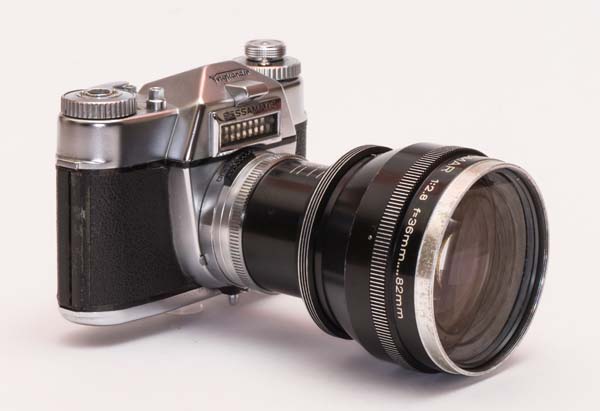
Very impressive yet, it offers f/2.8 and that justifies the imposing front set.
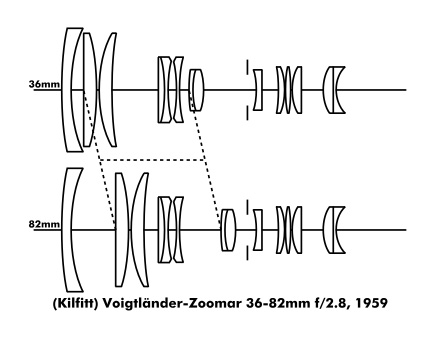
The Zoom itself is produced when a group of 7 elements moves inside the lens tube keeping the front and rear unchanged. The focus is made only by the movement of the front element. Altogether there are 14 glasses with 3 cemented doublets. A true design and production tour de force. This lens has already been optimized with the help of computers and due to its complexity it would probably be impossible otherwise. It was also a lens using new optical glasses.

Externally, to operate the zoom, a ring must be shifted longitudinally. This type of movement was maintained even in more recent zoom lenses, before a new generation using a rotating ring, such as the focus ring, replaced it.

Although made in Germany, the design was by Dr. Frank G. Back, from a firm of the same name, Zoomar, in Long Island New York. He was already developing lenses with variable focal length for cinema and TV and the very name Zoom, which is in use until today, was his creation. Such an important launch was not exclusive to Voigtlander. Zoomars were also produced for Exakta, Kodak Retina Reflex and Contax.
Taking about Retinas, it is possible to hack the lenses that fit in the Voigtlander mount to fit the Kodak Retina Reflex and vice versa. This is due to the fact that the shutter of the two is the same Synchro Compur. If you are interested, visit this page to see how it is done:Retina Voigtlander lens swap.

In addition, Bessamatic is a very usable camera. Despite being a little heavy with almost 1 kg, it has a tall body and this helps to maintain firmness. Some things can bother the photographer used to newer cameras, for example, the mirror does not return to its position after shooting. It is necessary to advance the film to arm it together with the shutter. Maintenance is expensive because access to the shutter is difficult. The entire lens block needs to be removed and this implies “disconnecting” the mechanisms triggered by the camera body. However, if used regularly and carefully, it is a camera that because it is all mechanical and very well built will last virtually forever.
- Zoomar 82mm
- Zoomar 36 mm
- Zoomar 82mm
